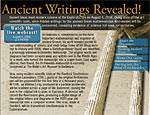Jonathan Yardley reviews And a Bottle of Rum: A History of the New World in Ten Cocktails by Wayne Curtis, in the Washington Post:
“Rum has always had a distinctly American swagger. It is untutored and proud of it, raffish, often unkempt, and a little bit out of control. The history of rum tends toward the ignoble, many times pleasingly so. . . . Rum, in short, has been one of those rare objects in which America has invested its own image. Like moonglow, the life of America is reflected back in each incarnation of rum.”
This may seem a strange claim for a nation with as strong a history of militant temperance and Prohibition as ours, yet there's more than a little truth to it. Rum was invented in the Americas — probably, though not certainly, in Barbados — and quickly became an important part of the diet in the American colonies, where consumption of alcoholic beverages was very high. Rum and slavery were intertwined, both in the slave trade and on plantations where rum was made. “Demon Rum” became a shibboleth of the temperance movement, and rum itself became one of the most widely consumed alcoholic drinks once Prohibition forced drinkers into speakeasies or onto ships bound for Cuba. During World War II, rum and Coca-Cola “became the de facto national drink of many of the troops,” and now the mojito is one of the most popular drinks among the fashionable young people who are bringing new life into the country's old cities.
More here.




















